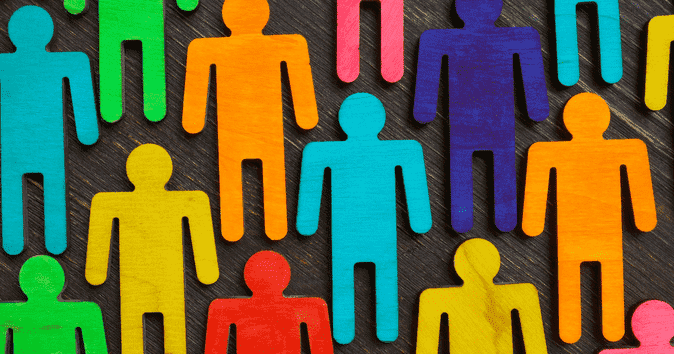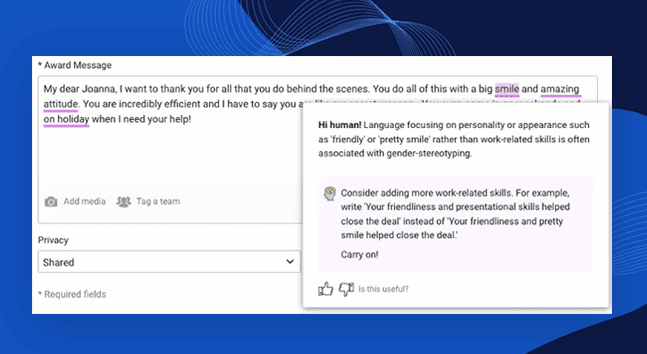What is Inclusive Language in the Workplace? Examples, Steps, & Strategies

What comes to mind when you hear the words “inclusion” or “inclusive language?” And what does inclusion look like in practice? You might think of a few examples from your own organization such as:
- Employee Resource Groups (ERGs) dedicated to representing and championing a variety of groups and interests.
- Flexible work schedules and hybrid options so as not to disqualify employees who work more effectively with greater flexibility.
- Facilities that are accessible and speak to the needs of a diverse workforce, including gender-neutral bathrooms, prayer rooms, providing meal options for a range of diets, and more.
Or, you might think more broadly about best practices for inclusion in the HR industry – inclusion training for leaders, inclusive hiring and promotion practices, and regular evaluation of the work environment and culture, to name a few.
See also: What is Inclusive Leadership?
Another important aspect of creating an inclusive environment at work (and beyond!) is the language we choose to use. Keep reading for a closer look into what inclusive language is, what inclusive language looks like, and strategies to incorporate inclusive language into your day-to-day life.
You’ll also learn how to promote diversity, equity, and inclusion in the workplace through mindful communication.

What is inclusive language?
The Linguistic Society of America (LSA) in its Guidelines for Inclusive LanguageOpens in a new tab, defines inclusive language as “language that acknowledges diversity, conveys respect to all people, is sensitive to differences, and promotes equal opportunities.” This includes not only considerations of race, gender, and culture but also supporting neurodiversity in the workplace, recognizing and respecting different cognitive styles and needs.
A central tenet of inclusive language is for people to think about the impact their words and phrases have on others. Inclusive language avoids terms, phrases, or expressions that could be racist, sexist, or biased against any group of people.
What does inclusive language attempt to do?
Inclusive language recognizesOpens in a new tab “that words matter and that word choice can be used, intentionally or unintentionally, to include or exclude others. Using inclusive language communicates with people in a way that is respectful and brings everyone into the conversation.”
Inclusive language also avoids making assumptions about people, steering clear of defaults that could make a person feel alienated or unwelcome.
The ultimate goal of inclusive language is to create an environment in which everyone is empowered to speak and feel confident that their voice will be heard. By choosing to use gender-neutral terms, avoiding terms that make assumptions or revert to defaults, and being mindful of historical context, we are actively working to include and create space for everyone to be their authentic selves.

Why is inclusive language important in the workplace?
Using inclusive language is an important step towards making everyone feel seen, heard, and valued. By choosing to use language that includes a wide range of individuals and groups, you can contribute to an environment of psychological safety and respect for all.
Promoting and using inclusive language in day-to-day communication sends a powerful message to employees:
- Reinforces diversity and inclusion as core values and central to the company culture
- Shows that people are thinking about the impact of their language and behavior on others, creating a human-centric workplace that puts people first
- Sets the stage for implementation of other inclusive practices
- Actively discourages exclusionary language and conduct
Benefits of inclusive language in the workplace
The goal of forward-thinking workplaces should always be about how to help their employees learn, grow, and develop. And when they do, the results are substantial and far reaching.
That being said, the benefits of using inclusive language in the workplace are manifold:
- Contributes to a sense of belonging, as people from a wide range of backgrounds feel welcomed, valued, and empowered to bring their full selves to work.
- According to Deloitte’s Human Capital TrendsOpens in a new tab research, fostering a sense of belonging is a priority for 79% of organizations, who agreed that the value of belonging was important to their organization’s success in the next 12–18 months.

How to make language in the workplace more inclusive (with examples)
One of the simplest to make language more inclusive is to swap exclusionary phrases for inclusive phrases.
Below are some phrases commonly used in life and at work that can be exclusionary or even offensive, as well as more inclusive alternatives to put into practice instead.
Non-gendered language examples
Much of our everyday language has an implicit bias toward two genders (male and female) and one sexuality (heterosexual), dismissing or outright erasing employees who identify as non-binary or part of the LGBTQ+ community.
Gender neutral or gender inclusive language acknowledges diversity by removing assumptions of a male-as-norm language and instead using a gender-neutral default — “they” instead of “he” — that is inclusive to employees of all sexual orientations and gender identities.
Alternatives to the male default exclusionary phrases
| Problematic Term | Inclusive Term | Guidelines |
|---|---|---|
| Chairman | Chairperson or chair | Use non-gendered language when referring to a person’s position, professional title, or occupation to avoid implicit bias that one sex is default for those roles |
| Man hours; Manpower | Work hours or hours; Workforce | Positioning men as the status quo excludes women and non-binary peoples. |
Avoid heteronormative language and gendered assumptions
| Problematic | Alternative Phrases | Guidelines |
|---|---|---|
| Hi guys; Hello ladies and gentlemen | Hi everyone, folks, or team | The generic or default “man” in place of “everyone” implies a hierarchy and inequity among the spectrum of gender and sexual identities. Addressing only men and women is also exclusionary and enforces a gender binary. |
| Husband, wife, boyfriend, girlfriend; Mother or father | Partner or significant other; Parent, caregiver, or guardian | Avoid gendered assumptions about employees’ family make-up and sexual orientation. |
Another simple step to avoid reinforcing the exclusionary gender binary is to normalize sharing pronouns. In hybrid workforces, adding pronouns to email signatures, Zoom displays, or Slack profiles creates a non-intrusive method for sharing gender identity.
Replacements for stereotypes and culturally appropriative phrases
Idioms, or phrases that mean something different than the actual words being used, can be quite common in an office, but bring with them complex or outright negative historical context. For one, “divide and conquer” may seem harmless shorthand for tackling a project strategically, but the phrase carries connotations of oppression and colonialism.
Many of these common turns of phrases can be harmful, appropriative, and inconsiderate.
| Term | Alternative | Historical Context |
|---|---|---|
| Gyp or gypped | Duped or tricked | Gyp/gypped is a racist term that describes being cheated or defrauded. It stems from the word ‘gypsy,’ which was originally applied to the Romani people. |
| Guru | Expert or authority | Used in Buddhist and Hindu religions to refer to a spiritual guide or leader, a Guru is a title of high esteem. To use it as shorthand for your experience with social media trivializes the importance of the title and its origins. |
| Tribe | Group, crew, community, or circle | “Tribe” becoming popularized is type: embedded-entry-inline id: 6JjQZKhJ77ucObvfTYfPVG and associates it with primitiveness or savagery offensive to African peoples. For Native American (First Nations) peoples, the term “tribe” is a bureaucratic word assigned by the U.S. government. |
| Spirit animal | Patronus or kindred spirit | The way “spirit animal” has been popularizedOpens in a new tab to mean a favorite or relatable animal, which type: embedded-entry-inline id: 74QhCjBrUbmi3oh7J9LvMb with nature. It also reinforces a stereotype that homogenizes a diverse group of peoples and customs. |
| Blacklist and whitelist | Blocklist or denylist and allowlist | These terms equate “black” with “bad” and “white” with “good,” which is a problematic and racist association. |
| Peanut gallery | Hecklers or jokesters | Peanut gallery is a phrase from the late 19th century that referred to the cheapest seats, or the section for Black people in segregated theaters. |
Consider also that idioms – even acronyms – may create communication barriers for global companies, or those with employees from across nationalities, religions, languages, and ethnicities.
Speaking plainly, especially in large and diverse groups is always a good rule of thumb.
Support racial identity and equality
Identity is essential to who we are, so misidentifying someone’s race or ethnicity can be extremely invalidating.
Rather than generalize a large number of distinct people into one racial group, like Asian or Hispanic, familiarize yourself with race, ethnicity and national origin identities.Opens in a new tab And when in doubt, asking the person respectfully in the appropriate setting is a good way to go.
| Problematic | Preferred Alternative | Guidelines |
|---|---|---|
| Hispanic (when used to refer to all Spanish-speaking nationalities) | Hispanic – descendants of all Spanish-speaking countries; Latino/Latina/Latinx – people of Latin American heritage | When it’s relevant to mention the race or ethnicity of a person or group of people, be specific.There are a number of terms for different ethnicities and nationalities, and people can have multiple racial and ethnic identities. It is best to ask what a person identifies with. |
| Minority or minority group | Marginalized groups, underrepresented groups, people of color (POC), Black, Indigenous and people of color (BIPOC); UK terms: Black, Asian and Minority Ethnic (BAME) or Black and Minority Ethnic (BME) | When referring to a diverse group of people, if you cannot be specific, Black, Indigenous and People of Color (BIPOC) is the preferred broad term.“Underrepresented” is also acceptable to describe a group in context. For example, “Latino workers are underrepresented in tech.” |
Ableist language examples and person-first alternatives
Ableist language is any language that is derogatory toward people with disabilities, that suggest that disability is abnormal, or perpetuate stereotypes of weakness.
This language bias can also implicitly define a person by their disability status. There are two approachesOpens in a new tab to combating this aspect of ableist language:
- People-first languageOpens in a new tab prioritizes the person over the disability, diagnosis, or chronic condition.
- Example: “a person with a substance use disorder” rather than “addict”
- Identity-first languageOpens in a new tab is used when an individual chooses to reclaim a disability, diagnosis, or chronic condition as a part of their identity or expression of cultural pride.
- Example: “Deaf person” rather than “person with deafness” or “hearing impaired”
Preferences on which language is correct to use vary by person and group and in general, it’s best not to assume a default and to address the individual based on their preferences.
| Problematic | Preferred Alternative | Guidelines |
|---|---|---|
| The disabled or handicapped person | People with disabilities or person with a disability | Put the person before the disability and avoid terms that imply the person is less than or weak.“The disabled” removes the humanity from a group of people by referring to them solely by a generalized disability status.Note that “disabled person” may be an acceptable term for individuals embracing identity-first language. When in doubt, ask! |
| Wheelchair bound | Wheelchair user or person who uses a wheelchair | Avoid language that frames any form of mobility equipment or assistive support as a limitation to the user. |
Again, these are general language guidelines and examples to help you identify exclusionary language and provide some guidance when you are unsure of an individual’s preferred identifier or the specifics of a groups’ identity.
Asking a person respectfully about their identity is the best way to get accurate information. That said, always stop and think about why you feel the need to ask first.
If you’re asking for someone’s pronouns to be respectful, find a private place to ask “what are your pronouns?” or better yet, normalize introducing yourself with your pronouns and asking others for theirs.
Any other questions about identity should only come after forming a relationship with a person or after they volunteer information.
And remember, no one should feel put-upon or uncomfortable when asked about their identity. A person may not feel psychologically safe enough in their environment to engage in discussions of identity.

4 strategies for building a more inclusive workplace for all
There are a lot of things to keep in mind when creating an inclusive workplace. But worry not: with a few mindset shifts and word choice changes, we’re one step closer to being more inclusive employees and people.
Here are four actionable strategies to implement in your organization to start building the most inclusive workforce possible.
1. Learning and Development
Offering continuous learning and development opportunities to employees around all topics is essential for the employee experience
Individuals can only do so much with the information they have in their head. By presenting opportunities for employees to learn about the struggles faced by marginalized communities as well as the unique benefits companies gain from employees with diverse backgrounds, employees have the chance to better educate themselves, making it easier to use appropriate language in everyday practice.
And because employees are learning together, these educational resources will likely become more engaging and interesting for employees, because they are all on the journey together. Not only that, but learning from those who have experienced the consequences of harmful stereotypes and biases themselves can make training more personable and meaningful to the employees involved.
2. Leading from the top
Peer pressure is typically seen as being negative, yet encouragement from others – is one of the most effective ways to uncover implicit biases and learn how to use more inclusive language.
Within an organization, this encouragement should be palpable from the top down. Business leaders must be transparent, open to learning, and most importantly, open to sharing these learnings with their people.
Did the CFO watch a new documentary on Indigenous peoples and the land in which your office sits? Share it in a company-wide email. If the VP of sales uses non-inclusive language in an interview and is subsequently corrected, shout it to the roof tops. Did an HR business partner read an article on inclusive ways to hire or new terminology to refer to a group of people? Make sure to spell it out in your next department meeting.
Employees must feel comfortable making, admitting, and then changing their mistakes both in and out of the workplace, and that becomes much easier when others are leading by example.

3. Auditing company language
It’s not enough to just talk about inclusive language, rather it must be actively considered in everything that the company puts out to the public, as well as to internal teams. Building in changes to make an environment more inclusive is essential for any inclusion strategy.
One of the best places for organizations to start is the company’s recruitment strategy – more specifically the language used in each job description. To begin, audit and analyze the language being used to promote job openings. Here are a few things to look for within the company’s job descriptions:
- First and foremost, remove any gendered pronouns or language from all job offerings
- Use plain language that does not assume the gender, sexual preference, race, or disability status of a candidate
- Remove any exclusionary language including but not limited to the examples shared in this piece
- Be mindful of the historical context of phrases and expressions and avoid using terms rooted in discrimination, racism, sexism, ableism, or racism in the workplace.
- Reassess the education requirements and experience level on all positions; often times organizations lose out on candidates with high potential that don’t even apply due to missing these requirements (jobs with specific education/training can break these out into “must haves” and “nice to haves”)
HR leaders should also be sure to look at where they are promoting these job descriptions. If the organization is looking for diverse talent (which they should be) they must be making sure their job postings are reaching those various groups.
4. Recognition microcoaching
An employee recognition program is one of the most effective ways to boost employee engagement and belonging, but only when it’s done right.
How can recognition be done wrong? After all, isn’t it just a simple ‘thank you’? How could anyone not do that right?
It’s easier to get wrong than you might think, but that’s where microcoaching comes in.
Microcoaching is the practice of using small, real-time moments to develop and teach employees. And when it comes to employee recognition, a microcoaching tool is a foolproof way to build inclusivity into the workplace.
Having a program in place that detects non-inclusive language and other forms of bias allows employees to learn on their own time, and in a safe, private space.
Inclusion Advisor from Workhuman® is an industry leading, AI-powered solution that does just that. Sitting within Workhuman’s Social Recognition® platform, Inclusion Advisor analyzes the words used in recognition messages to ensure the current language being used by the giver is inclusive and free from bias.
Learn more about Inclusion Advisor in this feature brief.

This powerful tool looks for common phrases and certain language like gendered terms, negative stereotypes, and offensive language against certain groups or cultural beliefs.
In real-time, employees can see if any of the words they used are non-inclusive, along with other expressions or inclusive terms to consider instead. And more times than not, employees will choose to change these words to something more inclusive, and are less likely to use the negative phrases in recognition messages and other forms of communication in the future.
Here, leaders from Merck discuss the successes they have seen since implementing Inclusion Advisor at their organization:
Conclusion
Stay tuned for more posts on inclusive language, including deeper dives into gendered phrases, ableist expressions, the historical context behind common sayings, and more ways to incorporate inclusive phrases into your everyday language!
This post is brought to you by Inclusion Advisor, the HR industry’s first AI-driven, in-the-moment DE&I coaching tool empowering users to make recognition inclusive for all.
About the author
Natural Language Processing Team
Caroline Kaine and Cassie Newland are members of Workhuman's NLP team and are the creators of our Inclusive Language in the Workplace Series.